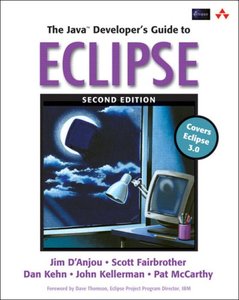The Java Developer's Guide to Eclipse
暫譯: Java 開發者的 Eclipse 指南
Sherry Shavor, Jim D'Anjou, Scott Fairbrother, Dan Kehn, John Kellerman, Pat McCarthy
- 出版商: Addison Wesley
- 出版日期: 2003-05-19
- 售價: $1,940
- 貴賓價: 9.5 折 $1,843
- 語言: 英文
- 頁數: 896
- 裝訂: Paperback
- ISBN: 0321159640
- ISBN-13: 9780321159649
-
相關分類:
Java 相關技術、Java 程式語言
已過版
買這商品的人也買了...
-
 計算機組織與設計--軟硬體界面第二版 (Computer Organization & Design, 2/e)
計算機組織與設計--軟硬體界面第二版 (Computer Organization & Design, 2/e)$680$537 -
 C++ Primer, 3/e 中文版
C++ Primer, 3/e 中文版$980$774 -
 Thinking in Java 中文版 (Thinking in Java, 2/e)
Thinking in Java 中文版 (Thinking in Java, 2/e)$920$727 -
 LPI Linux 資格檢定 (LPI Linux Certification in a Nutshell)
LPI Linux 資格檢定 (LPI Linux Certification in a Nutshell)$880$695 -
 Operating System Concepts, 6/e (Windows XP Update)
Operating System Concepts, 6/e (Windows XP Update)$1,050$1,029 -
 演算法導論 (Introduction to Algorithms, 2/e)
演算法導論 (Introduction to Algorithms, 2/e)$860$679 -
 JavaScript 範例活用辭典
JavaScript 範例活用辭典$450$351 -
 Sun Certified Programmer & Developer for Java 2 Study Guide, 2/e
Sun Certified Programmer & Developer for Java 2 Study Guide, 2/e$1,830$1,739 -
 PHP & MySQL 完全架站攻略第二版
PHP & MySQL 完全架站攻略第二版$620$527 -
 Red Hat Linux 9 實務應用
Red Hat Linux 9 實務應用$650$514 -
 Linux 核心程式設計 (Linux Kernel Programming, 3/e)
Linux 核心程式設計 (Linux Kernel Programming, 3/e)$580$458 -
 802.11 無線網路技術通論 (802.11 Wireless Networks: The Definitive Guide)
802.11 無線網路技術通論 (802.11 Wireless Networks: The Definitive Guide)$760$600 -
 Dreamweaver MX 互動網站百寶箱 for ASP
Dreamweaver MX 互動網站百寶箱 for ASP$580$493 -
 ASP.NET 程式設計徹底研究
ASP.NET 程式設計徹底研究$590$466 -
 Red Hat Linux 9 架站實務
Red Hat Linux 9 架站實務$620$490 -
 Embedded Linux 嵌入式系統原理與實務
Embedded Linux 嵌入式系統原理與實務$860$731 -
 Windows Server 2003 網路與 IIS 架站指南
Windows Server 2003 網路與 IIS 架站指南$680$537 -
 STRUTS 實作手冊(Struts in Action: Building Web Applications with the Leading Java Framework)
STRUTS 實作手冊(Struts in Action: Building Web Applications with the Leading Java Framework)$690$538 -
 程式設計專家手冊 (The Practice of Programming)
程式設計專家手冊 (The Practice of Programming)$420$332 -
 作業系統
作業系統$650$618 -
 深入淺出 JBuilder 程式設計實作(JBuilder 9.0/8.0/7.0 適用) (Charlie Calvert's Learn Jbuilder)
深入淺出 JBuilder 程式設計實作(JBuilder 9.0/8.0/7.0 適用) (Charlie Calvert's Learn Jbuilder)$720$562 -
 重構─改善既有程式的設計
重構─改善既有程式的設計$720$569 -
 鳥哥的 Linux 私房菜-伺服器架設篇
鳥哥的 Linux 私房菜-伺服器架設篇$750$638 -
 鳥哥的 Linux 私房菜─基礎學習篇增訂版
鳥哥的 Linux 私房菜─基礎學習篇增訂版$560$476 -
 CCNA Self-Study: Interconnecting Cisco Network Devices (ICND) 640-811, 640-801, 2/e
CCNA Self-Study: Interconnecting Cisco Network Devices (ICND) 640-811, 640-801, 2/e$2,260$2,147
相關主題
商品描述
"This book does an excellent job of helping you learn Eclipse. The practical examples and exercises included have been proven in real-life course situations and are invaluable in helping you to get up and running quickly."
—Dave Thomson, Eclipse Project Program Director, Object Technology International, Inc.
Eclipse is a world-class Java IDE, a platform for building and integrating application development tools, and an open source project and community. Written by members of the IBM Eclipse Jumpstart team, The Java™ Developer's Guide to Eclipse is the definitive Eclipse companion. Drawing on their considerable experience teaching Eclipse and mentoring developers, the authors provide guidance on how to customize Eclipse for increased productivity and efficiency and how to avoid common pitfalls.
Key coverage includes:
Those new to Eclipse will benefit from the directed exercises on using the Eclipse platform. Advanced developers can learn how to extend Eclipse and use this book as a reference to the Eclipse frameworks.
The accompanying CD-ROM contains Eclipse SDK Version 2.0, as well as exercise solutions and many code examples for easier learning. Whether you want to use Eclipse and Eclipse-based offerings as your integrated development environment (IDE), or customize Eclipse further, this book is your definitive reference.
Table of Contents
Foreword by Dan Thomson.
Preface.
Acknowledgments.
About the
Authors.
I. RUNNING ECLIPSE.
1. Getting Started.
2. Using Eclipse.
3. Using
Java Development Tools.
4. Debugging Java.
5. Teaming Up
with Eclipse.
6. Eclipse Configuration Management.
II. EXTENDING ECLIPSE.
7. Overview of the Eclipse Architecture.
8. Getting
Started: Plug-in Development.
9. Action Contributions: The
Integration Fast Track.
10. The Standard Widget Toolkit: A Lean Mean
Widget Machine.
11. Dialogs and Wizards.
12. Views.
13. Editors.
14. Perspectives.
15. Workspace
Resource Programming.
16. Managing Resources with Natures and
Builders.
17. Resource Tagging Using Markers.
18.
Contributions Revisited.
19. Advanced Plug-in Development.
20. Creating New Extension Points: How Others Can Extend Your Plug-in.
21. Serviceability.
22. Developing Features.
23.
Providing Help.
24. OLE and ActiveX Interoperability.
25.
Swing Interoperability.
26. Extending the Java Development Tools
(JDT).
商品描述(中文翻譯)
這本書在幫助您學習 Eclipse 方面做得非常出色。書中包含的實用範例和練習已在實際課程中得到驗證,對於幫助您快速上手非常寶貴。
— Dave Thomson,Eclipse 專案程式總監,Object Technology International, Inc.
Eclipse 是一個世界級的 Java IDE,是構建和整合應用程式開發工具的平台,也是開源專案和社群。由 IBM Eclipse Jumpstart 團隊的成員撰寫的《The Java™ Developer's Guide to Eclipse》是 Eclipse 的權威伴侶。作者根據他們在教學 Eclipse 和指導開發者方面的豐富經驗,提供了如何自訂 Eclipse 以提高生產力和效率的指導,以及如何避免常見的陷阱。
主要內容包括:
- Eclipse 的導航和術語
- Eclipse 與 Java 開發環境
- 擴展 Eclipse、插件架構和 Eclipse 框架
對於新手來說,使用 Eclipse 平台的指導練習將帶來好處。進階開發者可以學習如何擴展 Eclipse,並將本書作為 Eclipse 框架的參考。
隨書附贈的 CD-ROM 包含 Eclipse SDK 版本 2.0,以及練習解答和許多代碼範例,以便於學習。無論您是想將 Eclipse 和基於 Eclipse 的產品用作您的整合開發環境 (IDE),還是進一步自訂 Eclipse,本書都是您的權威參考。
目錄
- Dan Thomson 的前言
- 前言
- 感謝詞
- 關於作者
I. 執行 Eclipse
1. 開始使用
2. 使用 Eclipse
3. 使用 Java 開發工具
4. 調試 Java
5. 與 Eclipse 團隊合作
6. Eclipse 配置管理
II. 擴展 Eclipse
7. Eclipse 架構概述
8. 開始:插件開發
9. 行動貢獻:整合快速通道
10. 標準小部件工具包:精簡高效的小部件機器
11. 對話框和向導
12. 視圖
13. 編輯器
14. 觀點
15. 工作區資源編程
16. 使用性質和構建器管理資源
17. 使用標記進行資源標記
18. 重新檢視貢獻
19. 進階插件開發
20. 創建新的擴展點:其他人如何擴展您的插件
21. 可服務性
22. 開發功能
23. 提供幫助
24. OLE 和 ActiveX 互操作性
25. Swing 互操作性
26. 擴展 Java 開發工具 (JDT)



















